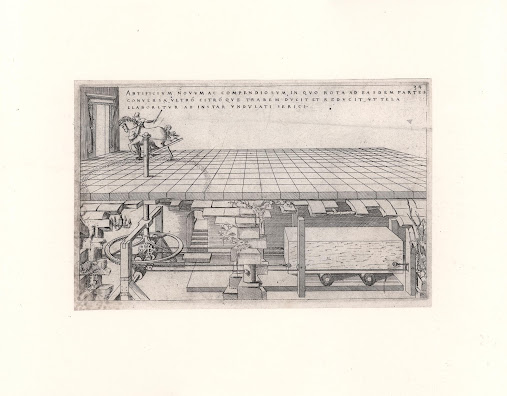Jacques
Androuet du Cerceau (c1520–1586), René
Boyvin (1525–1598) and workshop printmakers
“Plate 34: Horse-Power Mechanism for Moving/Cutting Stone” (descriptive title only with apologies for errors), 1569, a lifetime impression from the first edition (signified by the inscribed Latin text—later editions have the text on the verso of the preceding page [see https://archive.org/details/theatruminstrum00bessa/page/n77/mode/2up]) published in 1578 in Lyon in Jacques Besson (c1540–c1576) and François Béroalde de Verville’s (1556–1626), ”Theatrum instrumentorum et machinarum Iacobi Bessoni Delphinatis, mathematici ingeniosissimi".
Etching
with engraving on laid paper trimmed with a narrow margin around the platemark
and backed with a support sheet.
Size:
(sheet) 20.5 x 32 cm; (plate) 19.5 x 31.4 cm; (image borderline) 19 x 30.9 cm.
Numbered
and lettered in plate at upper edge: (right) “34”; (centre) “ARTIFICIVM NOVVM
AC COMPENDIOSVM, IN QVO ROTA AD EA SDEM PARTES/ CONV[E]RSA, VLTRÓ CITRÓQUE
TRABEM DVCIT, ET REDVCIT, VT TELA/ ELABORETVR INSTAR AD VNDVLATI SERICI–”
(translation with apologies for errors) “A new and comprehensive artificial
technique, in which the wheel is turned to the same parts, and leads the beam
back and forth, and reduces it, so that the web is elaborate like waved silk–”.
The Curator of the British Museum offers the following insights regarding the plates in this publication: “… 'Theatrum Instrumentorum et machinarum', a treatise written by Jacques Besson, illustrated by 60 plates (engraved by various artists including Androuet du Cerceau), and allegedly firstly published in Orléans in 1569, though it is also referred as a book firstly published in 1578 in Lyon.
This very popular work was republished several times, in Geneva (1594 and 1626), in Spain (1602) and in Nuremberg (1595)” (https://www.britishmuseum.org/collection/object/P_1850-0612-93).
Of
curious interest to me is the introduction of plants into this explanatory
diagram. Arguably this may suggest that the artist was providing an underground
context of roots and vegetative matter. Alternatively, perhaps the plants shown
growing on the stone block are to advance the notion of vanitas in terms of
nature “waiting” for man’s work to be abandoned. I also understand that at the
time there was interest in connections between the worlds of what lay
underground and above and the plants—especially the focus on their roots—may
reflect this concern. Of course, these thoughts are only my speculations and
the true reason for showing plants may be simply that the artist liked plants.
Condition:
a strong lifetime impression showing no sign of wear to the printing plate,
trimmed with a small margin around the image borderline and laid onto a sheet
of archival (millennium quality) washi paper. The lower left and right edges are stained,
otherwise, the sheet is in a good condition with no tears, holes, folds or
abrasions.
I am
selling this rare lifetime impression (c.1569/78) showing a Renaissance period
proposal by Jacques Besson for moving a large block of stone (e.g., marble) back
and forth to cut it by a mechanism powered by a horse for the total cost of
AU$253 (currently US$165.42/EUR152.55/GBP130.85 at the time of this listing)
including postage and handling to anywhere in the world, but not (of course)
any import duties/taxes imposed by some countries.
If you
are interested in purchasing this amazing illustration from what is arguably
the first published compendium of machine inventions—and certainly the most
influential! —please contact me (oz_jim@printsandprinciples.com) and I will
send you a PayPal invoice to make the payment easy.
This
print has been sold











No comments:
Post a Comment
Please let me know your thoughts, advice about inaccuracies (including typos) and additional information that you would like to add to any post.